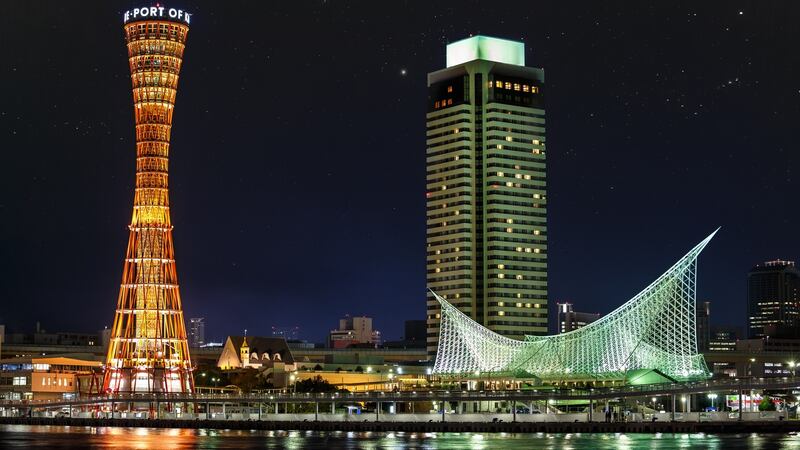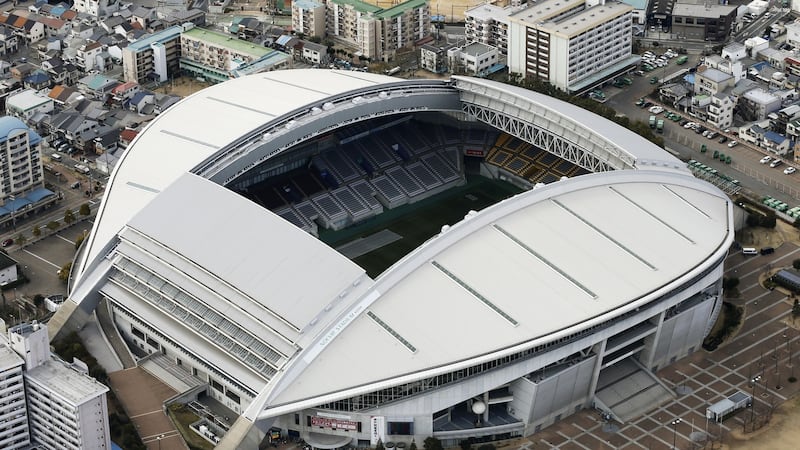Jack Cane, originally from Dublin, has lived in Japan six years, with more than four of those years in Kobe. He has worked as a teacher and writer. Cane, who studied Japanese history in university, says he loves the city most for its culture, food and language. He says the summers of constant 30 degrees and humidity at night can be challenging sometimes, and misses a “proper Guinness” but overall enjoys living there.
Kobe is a beautiful city and a wonderful place to live. It's often difficult to explain to visitors here that while it's a great city - clean, safe, stylish - it's not necessarily the most obvious for tourists. It's certainly not nearly as crammed with temples and shrines as Kyoto or a complete assault on the senses like Tokyo. However, it has many charms for Irish fans arriving in their droves to see Ireland play in the Rugby World Cup over the coming weeks to enjoy.
As a Dubliner, I’ve always loved how close the mountains and the sea are to the city. In Kobe most of the city centre is sandwiched between the wild, steep, sweltering slopes of the Mount Rokko range and the bustling harbour area. It’s easy to take a cable car up to the Nunobiki gardens and wind you way back down the mountain on foot. Keep a keen eye out for the slithering snakes and the roving wild boar on the trail down, of course. Given the late summer heat here, you can find people cooling off in the river at the bottom of the waterfalls found near the foot of the trail. The weather is normally 25 degrees or thereabouts in September. People here don’t usually wear jackets until October. It will probably be warm and a little humid at times, even into the evening.
Kobe has a fascinating history as one of the most westernised cities in Japan. It was home to a large foreign settlement from the 1870s onwards, and was the most important port for trade with the rest of the world. The city and port were razed by American bombing raids during the war. The port did recover but was then destroyed in the 1995 Great Hanshin earthquake when 6,434 people from the city and the surrounding area died.
Where to see
Walking around the salubrious area of Kitano, just to the north of downtown, you can get a feel for what life was like in the foreign settlement. Handsome colonial-style facades lead up the slopes to the mountains and bistros, wedding venues, jazz bars and small restaurants dot the landscape. The port facilities are largely gone from downtown, farmed out to artificial islands reclaimed from the bay. In their stead the glittering Harborland promenade offers shopping, restaurants, a Ferris wheel and the iconic Kobe Port Tower, but very little in the way of soul or historical interest.

For history, I like to turn back inland. Kobe is home to a vibrant and colourful Chinatown district that is well worth a wander through. Stalls teeming with aromatic food and an often festive atmosphere are attractive, even if a lot of the food is similar. The central square and the dragon statues give a flavour of a more Asian Kobe, especially with the upmarket western brand shops located a couple of streets away. Similarly, the centuries-old Ikuta Shrine is in the middle of the city and serves as a constant of calm among the hustle and bustle of the surrounding streets.
Where to eat
Getting lost in the warren of side streets to the north and west of Sannomiya station is never a bad idea when searching for a place to eat in the evening. Very reasonable ramen bars, kushikatsu (deep-fried skewers of meat and vegetables - don’t double-dip in the sauce) and yakitori (grilled skewers of meat) restaurants abound and yes, of course, there is the famous Kobe beef. Be aware that Kobe beef can be pricey and can be found cheap, but you often get what you pay for in this regard. A standard Kobe beef dish can cost anywhere from a few thousand yen to multiple tens of thousands. In euro you’re talking anywhere from €40 to €300-€400 for 150g of beef.
Teppanyaki restaurants offering various cuts of beef and okonomiyaki (a regional specialty that is a kind of pancake made with eggs, cabbage and different toppings and sauces - my personal favourite) are numerous and often delicious. One thing to do is to get on to the website Tabelog to find restaurants around Kobe, and elsewhere in Japan. Many Japanese wouldn't dare go to a restaurant without first checking it out on Tabelog, and with Google Translate this can be a great resource for finding places to eat.
Where to drink
Kobe's a fantastic city for drinking, even without a decent, spacious Irish bar to call its own. (For that you'll have to hop on a train and go 15 minutes to Akashi and Murphy's Irish Bar, which is worth the trip if you're feeling homesick.) There are a couple of big chain pubs and some local places such as The Harbor Tavern, IZNT and Midnight that will be showing games, and the aforementioned warren north of Sannomiya station has all the late-night watering holes a thirsty fan needs. Kobeites are often sociable and inquisitive. Be prepared to be thought of as British at first, but to be fair, it's not only the Japanese that are under that particular misapprehension. As with most places outside Ireland, don't bother with the Guinness as Japanese beer is more than adequate.
Guiness, British ales, craft beers and similar usually run about 1,000 yen (about €8). Japanese beers such as Sapporo, Kirin and Asahi are usually about 600 yen (€5) in bars and can be found at half the price in the cheap eateries I’ve previously mentioned.
Around the stadium
Noevir Stadium (or, confusingly, Misaki Park stadium), where Ireland will play, is located just a few subway stops from downtown. There's not an awful lot to do and see around the area of the stadium, so getting watered and fed in town before and after is recommended.

Although it’s not a large ground at about 30,000, the atmosphere generated at Vissel Kobe games is remarkable, particularly as the team itself has been nothing short of woeful this season. I’ve no doubt in my mind that the Irish contingent of fans will be able to blanket the place in sound and colour, and enjoy the country I have called home for six years.

















